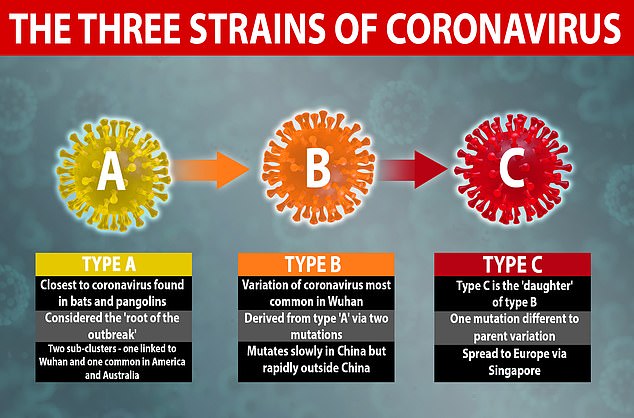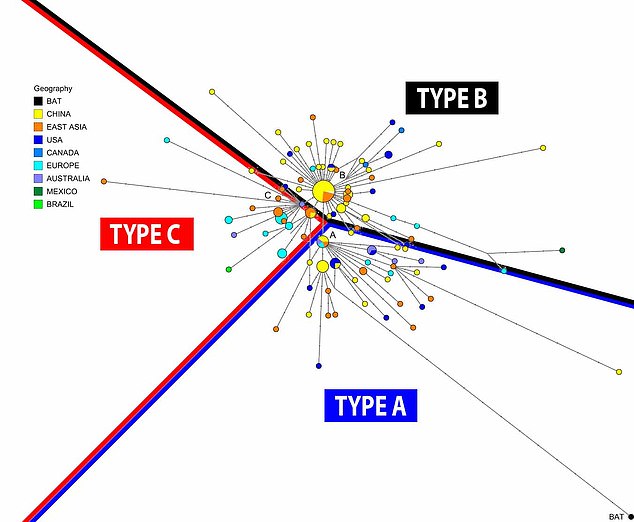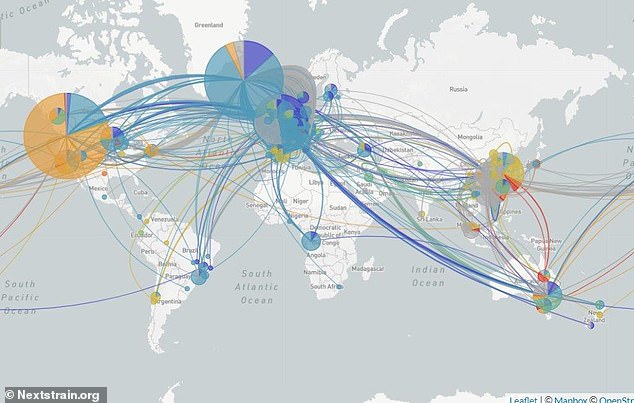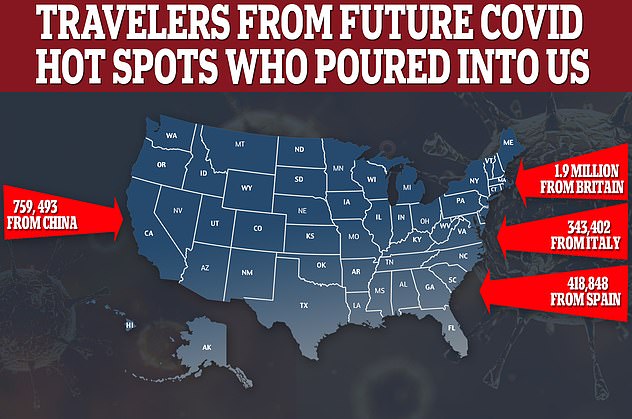There are THREE distinct strains of the novel coronavirus in the world and while China’s epidemic was driven by an early mutation that quickly spread in the UK, the US is suffering from an original variation
- Type A is closest to the one found in bats and pangolins and has two sub-clusters
- One sub-cluster linked to Wuhan and the other is common in US and Australia
- Type B is derived from type A and has become the most prevalent in Wuhan
- Type C is the ‘daughter’ of type B and was spread to Europe via Singapore
Three types of the deadly coronavirus are spreading around the world – and the US is being rocked by the original strain from China.Cambridge University researchers mapped the genetic history of the infection from December to March and found three distinct, but closely related, variants. Analysis of the strains showed type A – the original virus that jumped to humans from bats via pangolins – was not China’s most common. Instead, the pandemic’s ground-zero was mainly hit by type B, which was in circulation as far back as Christmas Eve.
Results showed type A was the most prevalent in Australia and the US, which has recorded more than 400,000 COVID-19 cases. Two-thirds of American samples were type A – but infected patients mostly came from the West Coast, and not New York.
Dr Peter Forster and team found the UK was mostly being bombarded with type B cases, with three quarters of samples testing as that strain. Switzerland, Germany, France, Belgium and the Netherlands were also dominated by type B.
Another distinct variation, type C, descended from type B and spread to Europe via Singapore.
Scientists believe the virus – officially called SARS-CoV-2 – is constantly mutating to overcome immune system resistance in different populations.

Dr Peter Forster and team found the UK was mostly being bombarded with type B cases, with three quarters of samples testing as that strain. Switzerland, Germany, France, Belgium and the Netherlands were also dominated by type B
The genetic history of the coronavirus was mapped from December 24 to March 4, revealing three distinct, but closely related, variants. Scientists believe the virus may be constantly mutating to overcome differing levels of immune system resistance in different populations.

Pictured, a breakdown of the different coronavirus genomes and to which of the three major group they belong to. The lines indicate a rough split between the type. The larger the circle, the higher the amount of cases
The study has thrown up an oddity that the original A strain spread through West Coast USA despite not being being the most prevalent in China, the B strain.
However because both strains were in existence by January, when US got its first case, it does not mean it arrived any earlier and was not detected. The researchers said the study was too small to draw any firm conclusions.The academics’ published work – which has been scrutinised by fellow scientists – only traced the samples of 160 patients across the world, including many of the first cases in Europe and the US.Methods used to trace the prehistoric migration of ancient humans were adapted to track the spread of the SARS-CoV-2 virus, which causes COVID-19.The team have now updated their analysis to include more than 1,000 COVID-19 cases up to the end of March to provide a clearer snapshot. It has not yet been peer-reviewed.
The smaller snapshot, published in the journal PNAS, initially suggested that type C was the most common in Europe.But the data now shows type B is spreading more rampantly – all but one of 31 SARS-CoV-2 samples taken from patients in Switzerland were of the second cluster.It comes after two separate genetic studies found most of New York’s outbreak came from Europe, and revealed the infection was being spread in mid-February – weeks before the city’s first confirmed case.
HOW DOES CORONAVIRUS HIDE IN THE BODY?
The SARS-CoV-2 virus has a large number of spikes sticking out of its surface which it uses to attach to and enter cells in the human body. These spikes are coated in sugars, known as glycans, which disguise their viral proteins and help them evade the body’s immune system.’By coating themselves in sugars, viruses are like a wolf in sheep’s clothing,’ explained Professor Crispin.The coronavirus has a relatively low level of sugar shielding.The lower glycan density means there are fewer obstacles for the immune system to neutralise the virus with antibodies.
Researchers at Icahn School of Medicine at Mount Sinai NYU scientists studied DNA from thousands of samples of coronavirus patients to conclude travellers from Europe brought the virus to the Big Apple.
But they also found that the strand of the virus that arrived in Washington state came from China, echoing the finding of Dr Forster and team.The Cambridge scientists found that two thirds of the 310 virus samples sequenced in the US were type A.And all of the American cases linked to cruise ships had type B strains. It is not clear what ships they caught the virus on – but the Diamond Princess, quarantined off the coast of Japan for weeks, recorded more than 700 infections.Data showed England’s first two cases – thought to be a University of York student and his mother at the end of January – had type A, suggesting they caught it in China.
No other samples from England, Scotland or Wales were type A, with almost 30 of the 40 viruses shown to be type B.Dr Forster told MailOnline it was possible the UK’s outbreak could be traced back to Italy but that the data was too limited to make any conclusion.The other cases recorded across Britain were type C, which is also likely to be traced back to East Asia.The UK’s first ‘super-spreader’ – father-of-two Steve Walsh – was known to have went to a business conference in Singapore and infected scores of patients in Sussex.Dr Forster told MailOnline that type A originally mutated into type B within China – but type C, the ‘daughter’ of B, evolved outside of the nation. He admitted scientists are clueless as to how type B ‘pushed aside’ its predecessor to become more common in China – but the question will be answered ‘one day’. Type B was found to be comfortable in the immune systems of people in Wuhan and did not need to mutate to adapt.
NEW YORK’S OUTBREAK CAME MOSTLY FROM EUROPE – NOT CHINA
The first cases of coronavirus in New York spread mostly from Europe, according to two scientific studies.Researchers believe the virus was being spread around the city by mid-February – weeks before New York’s first confirmed case.The scientists from the Icahn School of Medicine at Mount Sinai N.Y.U. and Grossman School of Medicine studied DNA from thousands of samples of coronavirus patients and concluded the first travelers to bring the virus to the city came from Europe, not Asia.
But they also found that the strand of the virus that arrived in Washington state came from China. Both research teams analyzed genomes from coronaviruses taken from New Yorkers starting in mid-March. One of the studies detected seven separate strains of viruses that arrived in the New York City area and researchers expect to find more. Despite examining different examples of the outbreak, researchers from both teams reached largely the same conclusions about its origins, according to specialists. Dr Harm van Bakel, a geneticist and co-author of the Icahn School’s study, told the New York Times: ‘The majority is clearly European.’
However, outside of Wuhan and in the bodies of people from different locations, the variation mutated much more rapidly.This indicated it was adapting to try and survive and overcome resistance among other populations, such as Westerners. Data analysis suggests the original strain of the virus could have been circulating in China as far back as September. And Dr Forster said the type B strain was ‘alive and kicking’ by Christmas Eve, their analysis revealed. It means the virus had already mutated before China recorded any COVID-19 cases – Wuhan first described an outbreak of a mysterious virus on December 31. He told MailOnline: ‘The majority of cases in Wuhan are B type while a derived C type later emerged and spread initially via Singapore.’And he suggested type C was not mutating – but called for caution over his finding, saying the sample was very small. Dr Forster added that the data used was just a snapshot and did not include tens of thousands of confirmed cases recorded in each country.
For example, China’s outbreak may mainly consist of type A – but the data analysed suggests that is not the case. Type A is the closest to the one found in bats and pangolins and is considered to be the ‘root’ of the outbreak. Type A has two sub-clusters and the first, labelled as the T-allele, has substantial links to East Asia as it was found in Americans that lived in Wuhan.However, the second A type sub-cluster, called the C-allele, is slightly different due to a string of mutations.In the study, the scientists said: ‘Nearly half of the types in this subcluster, however, are found outside East Asia, mainly in the US and Australia.’ The original study had access to 93 type B genomes and 74 were in either Wuhan (22), other parts of eastern China (31) or neighbouring Asian countries (21).A smattering were identified elsewhere, but type B had a strong affinity for Wuhan and is derived from type A via two mutations, at T8782C and C28144T.
The scientists argue that these methods could help predict future global hot spots of disease transmission and surge.
DNA Researchers believe the virus was being spread around the city by mid-February – weeks before New York’s first confirmed case. This map is based on an earlier based on an earlier genome study and shows eight different strains of coronavirus identified by scientists and how they have spread around the world

Travel data shows 3.4 million travelers from countries that would end up hardest-hit by the coronavirus outbreak entered the US as the pandemic was starting
In mid-March travelers coming to New York from Europe, where outbreaks in Italy and Spain were already spiking, were being asked at John F. Kennedy International Airport only if they had been to China or Iran, not if they had visited the hardest-hit nations in Europe, the Times reports.Both research teams analyzed genomes from coronaviruses taken from New Yorkers starting in mid-March. One of the studies detected seven separate strains of viruses that arrived in the New York City area and researchers expect to find more. Despite examining different examples of the outbreak, researchers from both teams reached largely the same conclusions about its origins, according to specialists. Dr Harm van Bakel, a geneticist and co-author of the Icahn School’s study, told the Times: ‘The majority is clearly European.’ Coronavirus mostly spread to New York from Europe and was sweeping through the city by mid-February, study of genomes reveals
The first cases of coronavirus that arrived in New York spread mostly from Europe, according to two scientific studies.Researchers believe the virus was being spread around the city by mid-February – weeks before New York’s first confirmed case.The scientists from the Icahn School of Medicine at Mount Sinai N.Y.U. and Grossman School of Medicine studied DNA from thousands of samples of coronavirus patients and concluded that the first travelers to bring the virus to the city came from Europe, not Asia, according to The New York Times. But they also found that the strand of the virus that arrived in Washington state came from China. President Trump banned entry to the US by foreign nationals who had visited China within the past two weeks on 31 January. He banned travel from Europe on 11 March.

It was not until late February that Italy would begin locking down towns and cities as well as imposing restrictions on mass gatherings. Although the New York outbreak appeared to originate in Europe, the Washington state cases appear to have come from China.Researchers found viruses in Washington, which was the first major outbreak in the US, shared mutations in common with ones isolated in Wuhan by Chinese medics. The first confirmed case in New York came on March 1 and around two weeks later new infections began to soar.
Previously researchers have said that coronavirus mutates very slowly with only tiny differences between the different strains. But a new study by Cambridge scientists found there are three main types of the novel infecting people, and the strains may be mutating to conquer the immune systems of populations around the world.
Last week travel data emerged showing 3.4 million travelers from countries that would end up as the hardest-hit by the outbreak entered the US as the pandemic was starting.
Figures from the US Commerce Department from December, January and February, which were the critical early months in the outbreak, reveal how hundreds of thousands or even millions of undetected coronavirus cases could have entered the country while medical experts remained unaware of the seriousness of the illness.
The world first heard about the virus in December, when it remained confined to China and mostly in the epicenter of Wuhan. Beijing was accused of covering up the spread of the virus, which may have left China’s borders through asymptomatic patients well before new cases were picked up around the world.
Isolated cases started showing up in Europe in late January, before the pandemic took off in Europe in February.The travel data shows 759,493 people entered the US from China before President Trump’s travel ban on 31 January.
Another 343,402 arrived from Italy, 418,848 from Spain and about 1.9 million more came from Britain.Medical experts say it cannot be known how many travelers may have been infected, but it’s highly likely some were not exhibiting symptoms.And as air travel has surged in recent years, enabling the pandemic to spread as it has, some officials suspect the virus’ true impact was happening sooner than they realized.
Trump has been criticized for not rolling out a widespread testing program when cases began spiking in the US.At least eight strains of the virus are being tracked by researchers around the world, using genetic detective work to show how the virus spreads. The virus appears to mutate very slowly, with only tiny differences between the different strains and that none of the strains of the virus are more deadly than another, experts say.They also added it does not appear the strains will grow more lethal as they evolve.Scientists also said that despite conspiracy theories falsely claiming the virus was made in a lab, the virus’s genome shows it began in bats. According to figures updated last night, coronavirus had infected 1.5 million people worldwide and killed nearly 88,000 people.
The US has seen more than 435,000 people infected and over 14,800 fatalities.
New York has suffered more than 150,000 cases with over 6,200 deaths.
Post Views: 13




